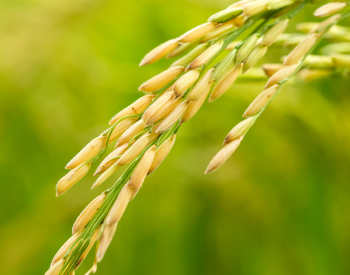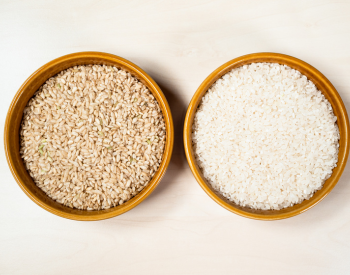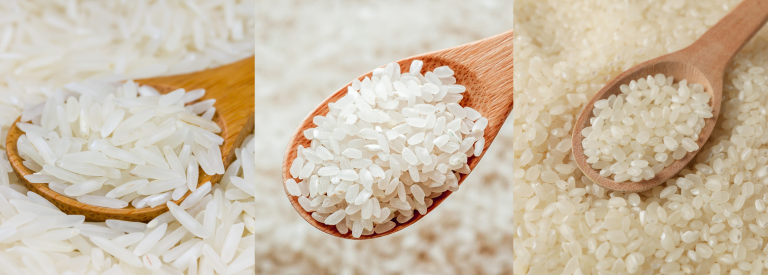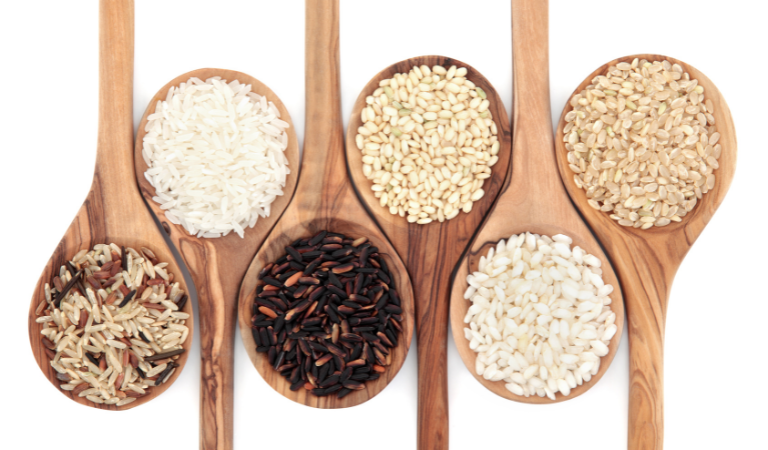Often underestimated yet playing immensely crucial roles in our diet, rice has managed to wedge its versatility into cultures, traditions, and give us daily sustenance on a global scale. With an estimated 40,000 varieties of rice sprawling across innumerable fertile lands, each one carries a unique melody of flavor, texture, and aroma, vibrating through a spectrum of cultural cuisines. Ranging from earthy, grain-based platters to aerial delights encrusted with spices, the rice grain indulges in versatility while maintaining its comforting simplicity. Join us on a journey that spills the canvas of the world on a grain of rice.
What Is Rice?
Digging deeper into the heart of it all, every grain of rice is a seed from the plant species 'Oryza sativa or 'Oryza glaberrima'. Unveiling a grain of rice layer by layer, we find that it contains:

- A Husk: The tough outer layer of the rice grain, also known as the hull. This protective covering encases the kernel and shields it from external elements and pests. Although the husk is inedible, it plays an essential role by providing a natural barrier for the more nourishing and delicate components inside.
- Bran: The bran is the nutritious layer that lies just beneath the husk. Rich in fiber, vitamins, and minerals, the bran contributes a specific color and a layer of texture to the rice grain. Whole-grain rice varieties such as brown, red, or black rice retain their bran, offering a more textured eating experience while delivering a broad spectrum of essential nutrients.
- Germ: The germ is the tiny nucleus of the rice grain, packed with essential fats, vitamins, and proteins. As the embryonic part of the seed, the germ is vital for the development and growth of a new rice plant. With the germ intact, whole-grain rice varieties offer a healthier and more nourishing culinary profile.
- Endosperm: The endosperm makes up the majority of the rice grain, providing a significant amount of energy through its high starch content. This component is the primary source of calories in rice and is responsible for the fluffy texture that has become synonymous with perfectly cooked rice. White rice, with its bran and germ removed, is mainly composed of endosperm, offering a softer texture and milder flavor profile.
Brown Rice Vs. White Rice: Two Sides Of The Same Seed

The primary difference between brown and white rice rests in the level of processing it undergoes. Brown rice, often celebrated as the healthier variant, retains its outer layers, bran, and germ, preserving an abundance of dietary fiber, a myriad of vitamins, and essential minerals. Conversely, white rice surrenders these nutritious layers, interpreting a more refined version of the seed composed largely of the starchy endosperm. This process extends the shelf-life of the grain and allows for a softer texture while providing a neutral base for a plethora of flavors to flourish.
Main Types Of Rice: A Triad Of Tasty Textures
The panoramic availability of rice types can predominantly be clustered into three categories: long grain, medium grain, and short grain, each defined by length, breadth, and the starch content that dictates their final cooked texture.

- Long-Grain Rice: Distinguished by their sleek, cynosure length, these grains cook into separate entities that are airy and fluffy to serve a light experience. This includes the fragrant Basmati rice from the fertile soils of the Indian land to the Jasmine rice native to Thailand that imparts the local flavor distinctively.
- Medium-Grain Rice: Strolling to the heart of the spectrum, this genre marks a balance, subtly starchy, creating a marriage between fluffiness and stickiness. Italian Arborio rice, an indispensable component in classic risottos, and Japanese Sushi rice, providing a mid-rice experience, both fall into this category.
- Short-Grain Rice: The showstopper in the world of 'stick-together' cooking is short-grain rice. With the Japanese Japonica adding quintessence to sushi and the Spanish Bomba rice simmering into a delightful Paella, the world meets at the crossroads of sticky comfort.
Popular Varieties Of Rice: Serving Global Palates
The gastronomic adventure of rice exploration takes us deeper into the landscapes of global kitchens, where the versatility of this humble grain takes on diverse identities.

- Basmati Rice: This elegant long-grain rice from the Indian subcontinent boasts a fragrant profile and a light, fluffy texture after cooking. Its ability to remain distinct and separate makes it an ideal choice for layered rice dishes such as Indian Biryani or Persian Pilaf.
- Jasmine Rice: A treasured culinary jewel of Thailand, Jasmine rice showcases an aromatic palette and a distinctive flavor. A bit stickier than Basmati, its bountiful essence enhances stir-fries, curries, and traditional Thai desserts.
- Arborio Rice: Bearing Italian heritage, Arborio rice is a medium-grain variety with a high starch content, resulting in a creamy, cling-together outcome that hugs each grain of rice in a risotto.
- Sushi Rice: Predominantly known for its use in sushi, this short-grain Japanese rice has a stickiness that holds together beautifully when molded, making it fundamental for sushi and okayu (rice porridge).
- Japanese Short Grain Rice (Uruchimai): This is the everyday rice of Japan, the gleaming backdrop of the Japanese meal. The sticky nature makes it perfect for eating with chopsticks.
- Japanese Sticky Rice (Mochigome): Glutinous rice, despite its name, lacks gluten. The term glutinous hints towards ‘glue-like’, signifying the high degree of stickiness in this rice. It is particularly used in many Japanese dishes, including mochi, a traditional Japanese sweet.
- Wild Rice: Native to North America, wild rice isn't traditional rice. It’s a species of grass with grains that brings a deep, nutty flavor and a pleasantly chewy texture to the plate, often served with game meats or in salads.
- Calrose Rice: A medium-grain variety that emerged from the Californian farming industry in the 1950s, Calrose rice matured into a significant ingredient in sushi and bento boxes due to its slight stickiness and ability to cling together.
- Valencia Rice: Hailing from the Spanish countryside, Valencia rice has a slightly rounded, short grain structure. It's often used for a variety of Spanish dishes, such as paella, due to its great capacity to absorb flavors. The well-known varieties of Valencia rice are Bomba rice, Bahia, and Senia.
- Red Rice: This whole grain rice carries a hull of red color. Offering a higher nutritional profile, it has a nutty flavor with a chewy consistency. It’s commonly consumed in the southern parts of India, Bhutan, and Thailand.
- Black Rice: Also known as forbidden rice, black rice was once reserved for Chinese royalty. Now valued for its high antioxidant content, its rich, slightly sweet flavor and striking color make it an excellent addition to salads and desserts.
- Brown Rice: Unhulled and minimally processed, brown rice retains its bran layer, responsible for its distinctive hearty flavor and chewy texture. Globally, it's appreciated for its high fiber and nutrient content.
- Long Grain White Rice: Standard in many Western and Asian households, Long Grain White Rice is versatile, featuring a mild flavor and fluffy texture when cooked.
- Parboiled Rice: This rice is boiled in its husk through a steam-pressure process before milling, which contributes to its yellowish tint. Native to the Indian subcontinent, parboiled rice is valued for its low Glycemic Index, making it suitable for people with sugar concerns.
These numerous varieties, with their various profiles and uses, showcase why rice has become an indispensable part of global cuisine. Every culture has embraced it differently, tailoring their cultivation and cooking methods according to their unique taste preferences. It is this very diversity and versatility that make rice a culinary constant, transcending continents and cultures.
Unraveling The Husk: Summing It All Up
Rice weaves its tale of comfort and culture through the strands of every cuisine, from the humble, healing pots of porridge to lavish, layered delicacies hosting a lively sensory fiesta. Be it the luxurious, satin grains of Basmati echoing tales of royal Indian banquets, the creamy tendrils of Arborio binding a heart-warming risotto, or the delicate stickiness of sushi rice sewing together splashes of umami, rice truly wears the crown of a great culinary unifier.
Whether it's the long grains of Basmati rice exploding with flavor in biriyani, the Arborio rice elevating a risotto, or the sticky sushi rice binding together the umami flavors, rice truly plays a significant role in culinary harmony.
Embrace The Grainy Adventure!
As the lid rises from our metaphorical pot of perfectly steamed rice, let it continue to unveil its diverse presence across the world, basking in incredible flavors and zest. Step into your kitchen, armed with a spoon and inspiration, and invite a world of grains into your home, cooked to perfection and infused with love.









